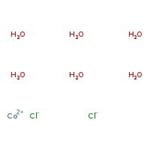Search Thermo Fisher Scientific
Cobalt(II) chloride hexahydrate, 98%, Thermo Scientific Chemicals



Cobalt(II) chloride hexahydrate, 98%, Thermo Scientific Chemicals
Chemical Identifiers
Specifications
Description
This Thermo Scientific Chemicals brand product was originally part of the Alfa Aesar product portfolio. Some documentation and label information may refer to the legacy brand. The original Alfa Aesar product / item code or SKU reference has not changed as a part of the brand transition to Thermo Scientific Chemicals.
Cobalt(II) chloride hexahydrate is widely used as a drying agent in painting and coloring agents for glass ceramics. It is an excellent indicator for water in dessicants as well as an indicator for silica gel dryer. It helps in electroplating. It acts as an inducer of HIF-1 production used to study apoptotic effects in HepG2 cells.
Solubility
Soluble in water, ether, acetone and alcohol.
Notes
Incompatible with strong oxidizing agents and metals.
Figures
Documents & Downloads
Certificates
Frequently asked questions (FAQs)
Citations & References
Safety and Handling
Classification of the substance or mixture
CLP classification - Regulation(EC) No 1272/2008
Label Elements
Signal Word
Danger
Hazard Statements
H302 + H332 - Harmful if swallowed or if inhaled
H317 - May cause an allergic skin reaction
H334 - May cause allergy or asthma symptoms or breathing difficulties if inhaled
H341 - Suspected of causing genetic defects
H350i - May cause cancer by inhalation
H360F - May damage fertility
H410 - Very toxic to aquatic life with long lasting effects
Precautionary Statements
P280 - Wear protective gloves/protective clothing/eye protection/face protection
P301 + P330 + P331 - IF SWALLOWED: rinse mouth. Do NOT induce vomiting
P302 + P352 - IF ON SKIN: Wash with plenty of soap and water
P304 + P340 - IF INHALED: Remove person to fresh air and keep comfortable for breathing
P312 - Call a POISON CENTER or doctor if you feel unwell
P333 + P313 - If skin irritation or rash occurs: Get medical advice/attention
Additional EU labelling
Restricted to professional users